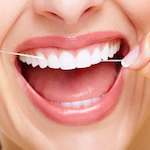Flossing
Written by Advice Team on February 10, 2016
Using dental floss or an electric water flosser can help prevent gum disease by removing left over pieces of food and plaque from between your teeth. Plaque is a mass of bacteria that builds up on the teeth and is the main cause of gum diseases such as gingivitis and periodontitis as well as dental cavities, tooth decay and bad breath so it’s important to build flossing into your daily dental routine.
In order for dental floss to effectively remove plaque from your teeth without causing damage your gums you need to be sure you’re using the correct technique. The following tips will help you to floss your teeth properly.
1. Break off a piece of dental floss (or dental tape which is thicker than floss and easier to use) about 18 inches long. The objective is to use a clean segment of floss for the gap between each tooth so ensure you have enough.
2. Wrap the majority of the floss around the middle finger of one hand and a small amount onto the middle finger of the other hand. Some people prefer to use their index finger but this makes the floss slightly more difficult to manipulate.
3. Using a length of floss between 3cm and 5cm, keep the floss tight between your fingers and thread the floss through the gaps between your teeth. Gently slide the dental floss between the teeth in a zigzag motion. Work carefully around the base of the teeth near the gum and be careful not to let the floss snap between teeth to avoid causing damage or bleeding.
4. Repeat for each gap between all of your teeth using a clean length of floss for each gap. Work carefully and methodically around your mouth to ensure you do not miss any teeth out and don’t forget to floss the back side of each tooth.
When you floss initially, it is possible for your gums to bleed and feel sensitive as you begin to get rid of the plaque build-up. This is normal and should stop after a few days but if you're still getting bleeding or pain after this time, see your dentist. It is certainly worth building up slowly during these first few days, while you find the right technique and to give your gums time to adjust.
If you find flossing difficult, there are appliances you can use such as oral irrigators, sometimes called electric water flossers. These devices work by using pressurised water to gently but powerfully clean between all of your teeth. This can be a good alternative if you have particularly sensitive gums. Some manufacturers claim they can remove up to 99% more debris than manual brushing alone and up to 5 times more plaque than regular flossing, all in a time of just 30 seconds!